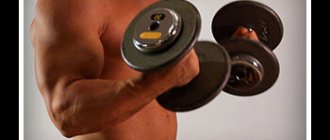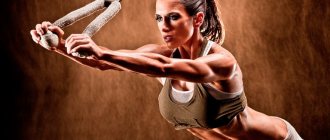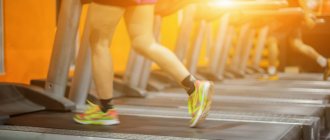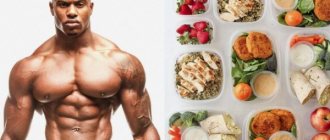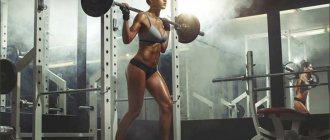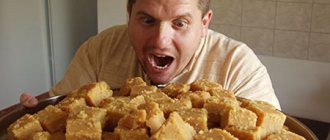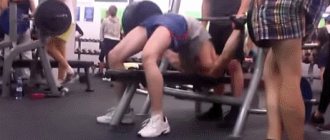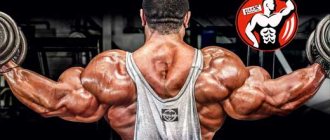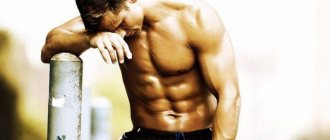Elderly people often feel discomfort in different parts of the body. Mostly the limbs and back hurt, which is associated with increased work of the muscles of the organs that are most involved in the work.
Such signs are a consequence of both disease and muscle weakness and atrophy. To avoid discomfort, old people stop loading themselves, this leads to rapid weakening and can cause injury and even disability.
With the right approach, it is possible to neutralize unfavorable processes and ensure muscle function in a satisfactory condition over a fairly long period of time.
Elderly people who play sports live to a ripe old age while remaining quite active.
Why do muscles hurt?
Discomfort when working certain areas of the muscles in old age occurs primarily due to lack of training or the presence of a pathological process. As a rule, people who initially take care of their health try to maintain their tone in proper condition, which allows them not only to maintain the body in working condition, but also to achieve stable immunity and not complain of cardiovascular problems.
The note. Muscle pain in old people is not always a symptom of any disease. This is often a sign of weakness due to loss of connective tissue. Such conditions can lead to the formation of myopathies - inflammation of actinomyosin tissue under the influence of significant physical activity.
If a pathological process is suspected, the doctor must conduct an examination of the patient (the cost is not so high) to determine the cause of the discomfort. In addition to a physical examination and history taking, ultrasound, x-rays and blood tests (general and biochemical) can tell a lot.
In pensioners after 60–67 years of age, the following ailments should be suspected:
- rheumatoid polymyalgia;
- diabetes;
- endocrine diseases, for example, disorders of the thyroid gland;
- chronic negative transformations after trauma, etc.
Note. Muscle pain is observed in people suffering from atherosclerosis. Side effects can occur when taking statins. In this case, the doctor must adjust the therapy or prescribe analgesics to eliminate negative symptoms.
A sedentary lifestyle leads to hypertrophy of the motor muscles.
The main cause of muscle pain in older people should still be considered processes associated with the mechanisms of aging. Scientists have found that after approximately 30–35 years, the average person who does not engage in any sport loses about one percent of their total muscle mass annually.
Thus, by approximately 70 years, the number of working muscles in a person is reduced by one and a half times due to partial loss or atrophy. The remaining part takes on all the loads and provides motor function, which leads to fatigue.
In addition, it is important to take into account that the efficiency of actin and myosin is already much weaker than at a young age.
Cardio loads
In training after 40 years, it is necessary to include various types of cardio loads. This is good stimulation and training for the cardiovascular system. Put low-intensity cardio training first, but with a long duration. This can be walking at an average pace. Among intense cardio exercises, it is better to try interval cardio with a short duration.
READ MORE: Letrozole in bodybuilding: how to take it for PCT, contraindications
How power is lost
Around the age of 60, people begin to noticeably feel muscle weakness. By this time, there are already a number of chronic diseases, which increases the negative impact on overall health.
At this age, people who have not previously attached importance to therapeutic exercises or other types of light sports should think about the causes of discomfort. It is important to understand that disease prevention is much simpler, easier and cheaper than the fight against developed pathology.
Important. The presence of pain in old age cannot be considered the norm, because aging is a natural process and it should not bring suffering. Negative symptoms always indicate the presence of a pathological process.
Undesirable processes are initially faintly noticeable. Often, even if there is discomfort, it is attributed to characteristic features inherent in the aging process.
This is wrong and quite dangerous. If you start taking care of your body, you can prevent or significantly delay weakness or disability.
Pay attention to the characteristic stages of the formation of muscle pathologies in old age:
- The slowdown in active muscle activity begins with a reduction in the number of functional cells. This leads to tissue dystrophy and a reduction in neuromuscular interactions. Ultimately, atrophy processes begin.
- Functional abilities deteriorate, work slows down, movements are no longer as strong. It takes longer to recover.
- Reducing physical activity. An old person finds it difficult to move. Over time, this intensifies and progresses to the point that the pensioner has great difficulty walking up the steps, getting out of a chair, and so on.
- Disability or a condition extremely close to it occurs. The old man becomes sick, walking without a cane or the help of strangers is no longer possible. In the worst case, the movement is carried out in a wheelchair or the person does not stand up at all.
The above is a brief and highly simplified consequence of an aging person's refusal to exercise.
Gymnastics classes are suitable for almost all pensioners
Exercise in old age
Classical strength training is not recommended for aging individuals. When playing sports, you should focus on the speed-strength version of training, in other words, focus not on strength, but on speed.
This is important for pensioners, because this way they can maintain muscle functionality at a fairly high level, and this will allow them to provide all the necessary manipulations independently, without outside help, much longer. You should work out at home or in the gym with light weights, while maintaining an acceptably high rhythm. You need to make sure that your breathing does not become shortened and your heart rate does not increase.
Important. In old age, it is recommended to work out with a trainer and undergo a medical examination every six months.
For an elderly person, two workouts lasting 1.5–2 hours per week will be enough.
Recommended sports and exercises:
- bike;
- swimming;
- light jogging, Nordic walking, long walks;
- rowing, catamaran;
- a set of exercises with dumbbells;
- training on simulators (with a trainer);
- active sports games;
- squats;
- gymnastics;
- yoga and others.
In this case, it is important that the number of approaches and sets, frequency, speed and other training factors cannot be the same for everyone. For each person, you should select the optimal types of sports and intensity, develop a program that will be useful not only for muscles, but also for health in general.
You need to consult with your doctor so as not to complicate existing diseases; for example, running or weight training cannot be recommended for people with heart disease in old age.
In old age, you need to give up training with heavy weights, and concentrate more on the speed of performing movements with a small load
Stick to a diet
To strengthen muscles and restore their mass, the body will need a lot of protein. Its main source is animal protein. It is imperative to include chicken eggs, dairy and seafood, and lean meat in the menu. A catabolic diet shows good results - eating foods with “negative calorie content”, i.e. those that require more energy during digestion than they provide. These are fruits and vegetables - pineapples, melons, apricots, raspberries, peppers, cucumbers, tomatoes, broccoli, eggplants.
Protein in the diet
The proportion of protein in the daily diet should be 1.3 grams per 1 kilogram of body weight. The protein and amino acids that the body receives from meat, cottage cheese or milk will serve as building materials for muscle recovery.
Products that contain leucine will play a special role in the diet. This amino acid is often used in sports supplements and helps strengthen muscles and actively burn fat.
Leucine contains:
- legumes;
- nuts;
- turkey meat;
- red meat;
- whole milk;
- seafood;
- corn, rice
Healthy fats
Although the goal of a diet for sarcopenia and sarcopenic obesity is to get rid of fat and build muscle, fat must be supplied to the body. Their source will be plant foods, oils, and dairy products.
It is important that the body receives more Omega-3 fatty acids: they are more difficult to digest and do not go into the formation of fat, help stop inflammatory processes, and participate in the synthesis of muscle cells.
Almost all seafood contains Omega-3 acids. In addition, you can get them from capsules with fish oil or flaxseed oil.
- New indexation of social pensions in April
- How to toilet train a kitten in an apartment
- Desk lamp
Nutrition
Physical activity will be difficult and give poor results if a person does not adhere to the basics of nutrition. In old age, you should not engage in cutting or, on the contrary, overeat in anticipation of gaining muscle mass.
It is important to understand that the muscles are no longer strong, they recover poorly, do not grow, and the functioning of the gastrointestinal tract is not the same as in younger years. To prevent atrophy and loss of actin-myosin tissue and increase strength, it is necessary to provide the body with all the necessary elements (table), especially when a person plays sports.
Table. Basics of a nutritious diet for physically active older adults:
| Diet elements | A comment |
| These are energy sources. It is recommended to eat before training and build the basis of your daily nutrition on it. Slow carbohydrates are extremely useful: cereals, plant foods, cereals. Sweets are allowed, but it is important not to pass them on because there may be problems with blood glucose and cholesterol levels. |
| These are the main sources of amino acids for building muscles. Main products: lean meats, all dairy, cheeses, eggs, shellfish, fish, legumes. However, such food is quite difficult for an aging body; there is a risk of developing stomach diseases and even cancer (if you constantly eat red meat). Therefore, 200-300 g of protein per day from any of the listed products will be enough. |
| Lipids are needed for cell membranes and the synthesis of biologically active substances, but overeating is dangerous for many diseases. Fats are valuable sources of energy, so it is better to eat them before physical activity, rather than after. It is extremely important to monitor your weight. Old people are recommended to use vegetable oils and eat raw lard (at the rate of 30 g/day). The latter is valuable for epithelial cells. |
In addition, it is important to ensure that the body gets enough vitamins and minerals. This will strengthen the immune system and help maintain the synthesis of hormones and other important biological substances.
Understanding that in old age fewer useful components are already absorbed should make a person more careful about food and food choices. Bad habits should be completely eliminated.
Water aerobics or swimming is a great way to keep an old person's body in proper tone.
Increase your physical activity
In the absence of contraindications to sports, this is the best way to build muscle mass. Any aerobic exercise or complex cardio endurance training works well as a physical activity. You can use exercise equipment: an exercise bike or a treadmill.
For older people who suffer from chronic fatigue and constant weakness, short (but daily) race walking at low speed or regular walks are suitable.
If your health allows, you need to add strength exercises with weights: they do a better job of restoring skeletal muscle mass than cardio exercises. The training program should include: weight lifting, expander stretching.
It is important to try to create and overcome loads that exceed the capabilities of the muscles. Then the muscle fibers will begin to stretch more, sending a signal to the brain to activate cell growth and restoration.
- How to avoid getting an infection on public transport
- Foods that accelerate aging
- 3 Sleep Myths That Are Harmful to Your Health
